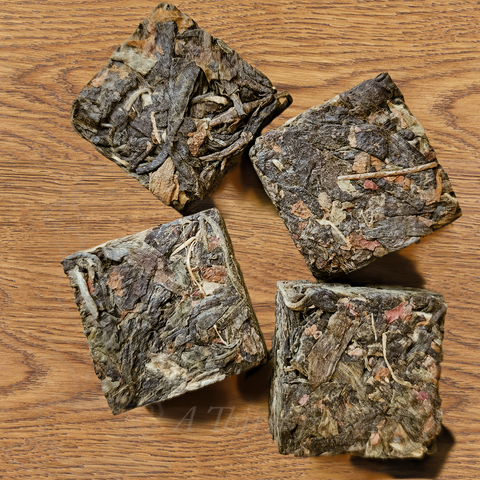Two Dragons Playing with Pearls Blooming Tea
$2.30Two Dragons Playing with Pearls Blooming Tea
$2.30- Gallery
- Description
- Blooming Tea Background
- Blooming Tea Preparation
- Reviews
Two Dragons Playing with Pearls is made with the highest grade Huangshan Maofeng green tea, which is hand tied around marigold flowers, jasmine and red globe amaranth flowers. Huangshan Maofeng is one of China's most famous green teas with a 400 year history. The cup produced as the pod unfurls is nothing short of remarkable. Intensely delicate, the bright, pinkish infusion fills the mouth with mellow floral notes layered over the fresh sweet taste of the tea. A wonderful sipping tea. On the nose the infused tea is a delight, hinting of a Fujian garden in the springtime. The cup displays delicate, mellow floral notes. On top of it all, the tea is a visual spectacle -- truly a cup to behold!
Ingredients: Huangshan Maofeng green tea, marigolds, jasmine and red globe amaranth flowers.
Origin: Huangshan, Anhui Province, China
The custom of blending flowers with green tea has existed for over a thousand years as far back as the Song Dynasty (960 AD to 1279 AD.) The most widely used flower was jasmine, used for it's incredible scent, but other flowers have also been used over the centuries. Chrysanthemums, globe amaranth, roses & lilies are also popular flowers used. It is believed that Jasmine tea was first produced during the great cultural flowering of the Song Dynasty. The Dynasty, which flourished from 960 to 1279, gave rise to a Chinese renaissance that saw the growth of great cities fuelled by advancements in governance and the arts. In the same way that the European Renaissance gave birth to the idea of the Renaissance man, the ideals of the Song Dynasty gave rise to the Universal man. The Universal man personified the cultural blossoming of the time and combined the qualities of scholar, painter, poet, statesman, writer, calligrapher, and philosopher. Along the way, one such man, perhaps contemplating life under a sweetly smelling Jasmine tree, hit upon the idea of scenting freshly made tea with the delicate blossoms.
Over the centuries since then, artisans from nearly every tea-growing region in the country have rolled, tied and twisted hand plucked green leaf with flowers and herbs to create what can only be described as drinkable works of art. The level of care that went, and still goes into, producing these wonderful teas meant that only the finest ingredients could be used – the best tea shoots available and additional ingredients that commanded the same respect as the tea itself . The artisan chooses his ingredients both for flavor profile and texture, but also for color and impression. The blooms must be the brightest and fullest. The tea must be harvested meticulously and processed masterfully. Mid-way through the processing stage, when the leaves are still damp, the blossoms are tied by hand, woven into the tea and pressed into their unique forms. The tea dries and all the colors and flavors are concealed just waiting to reappear in a burst of frantic tea energy.
Brewing Instructions
Water Temperature: 185-195 degrees--Display tea requires hotter water than normal green tea in order to properly open
Water Quality: Best with Spring Water
Amount (per 6 fl oz water): 1 display tea ball
Steep Time: 3-5 minutes or until the display tea ball sinks to the bottom of the pot and fully unfolds. The display tea does not get bitter as fast as regular tea, so it is safe to add time to the steeping.
Number of Infusions: 3-4
Our blooming artisan teas may be prepared in a standard glass teapot, or in your favorite glass mug or wine glass. For best results, we recommend that you pre-warm your vessel, and place one tea ball per 6 oz of liquid, before infusing with 185-195 degree water for 3-5 minutes. Flowering teas can be infused at least three times. Increase the time and temperature slightly with each subsequent infusion. Experimenting with your own temperatures and steeping times is encouraged, especially with such a forgiving tea. Cooler temperatures and shorter times yield more mellow, fruity elements, while hotter water and longer times produce more floral and full-bodied complexities. Always use the best-tasting water you can find, and adjust steeping times and water temperature to your personal preferences.
We highly recommend brewing Flowering teas in a glass teapot, mug or even a wine glass so that you can see the tea and flowers unfurl and expand in the water performing their "magic."




























